
Key Statistics
Table of Contents
Today we are diving into the fascinating world of marriage and divorce statistics.
Whether you have yet to walk down the aisle or have long since tied the knot, it's in your best interest to be familiar with these statistics as the data has been painting a rather bleak picture over the last 30 years.
We'll be examining the numbers behind marriage and divorce and learn about marriage and divorce trends over the years and how the attitudes and behaviors towards marital status have changed.
Some will be very different from what you thought and many divorce statistics will challenge your predetermined misconceptions on marriage rates and divorce rates.
Things like ethnicity, religion, politics, and even what state you live in can make a huge difference to what part of a marriage and divorce survey you fall into. Age too plays a big part in the likelihood of you ending up getting divorced. Read on to find out whether you improve your chances of a happy relationship the younger or older you marry.
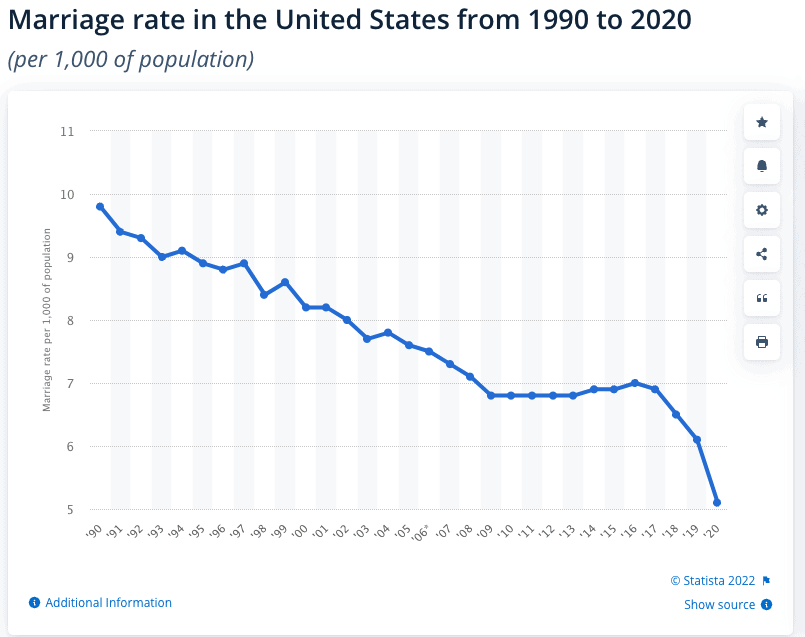
As can be seen, the overall trend for the last thirty years is the fact that the marriage rate has gone down practically halved.
While in some years that rate did increase, by and large, year after year that rate fell consistently.
There was one passage of time recently that bucked that trend, which saw the years from 2013 to 2016 display a rising rate of marriage, year on year. This was quickly reversed with the onset of the global pandemic which resulted in a further rapid drop in the marriage rate.
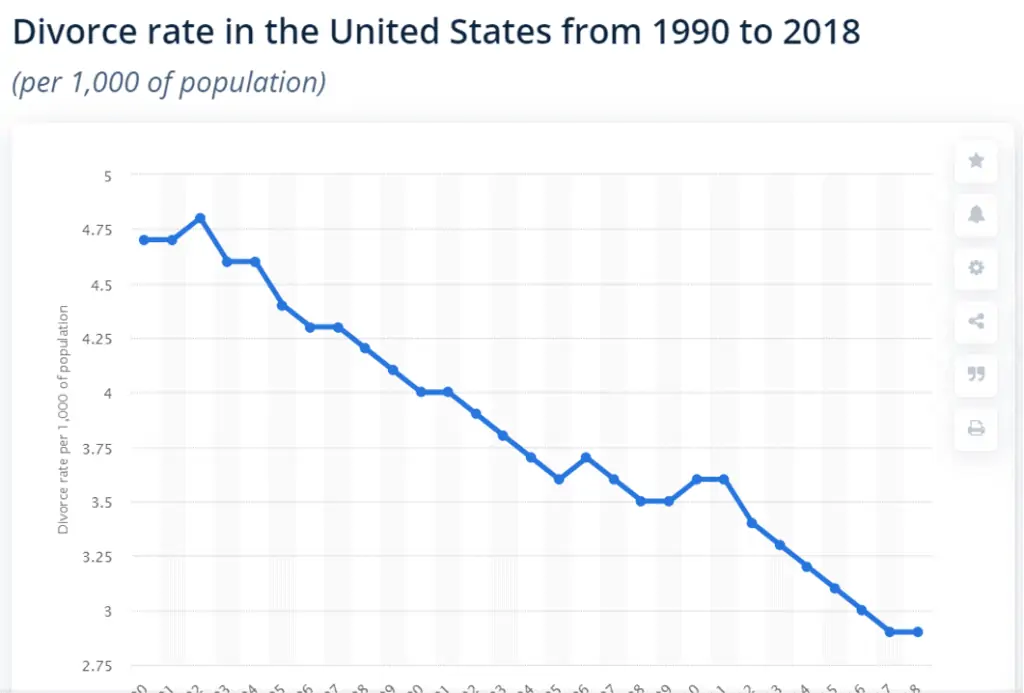
This is perhaps one of the clearest trends that show how divorce decreases have been a fairly constant occurrence in the United States over the last thirty years. We started the 90’s seeing the crude divorce rate rise to almost 5 in every 1,000 of the population. At the end of 2018, that had fallen to just under 3.
In fact, more surprising still is that the divorce rate continually decreased or stayed the same almost every year. There were only three years, 1992, 2006, and 2010, where the divorce rate went up. Even then it was a minimal uptick before returning to the downward trend that characterized the last thirty years.
These numbers in this graph take into account all marriages. It does not only take into account a person’s first marriage but instead any divorce - regardless of the number of marriages a person has had in the past - is counted to gather the overall divorce rate in the United States over the last three decades.

This graph shows the fact that in the first 14 years of the new millennium, fewer couples were getting divorced, but equally, fewer people were getting married in the first place. In fact, the number of marriages taking place decreased at a rate that was quicker and bigger than the amount that divorce decreases in this sample.
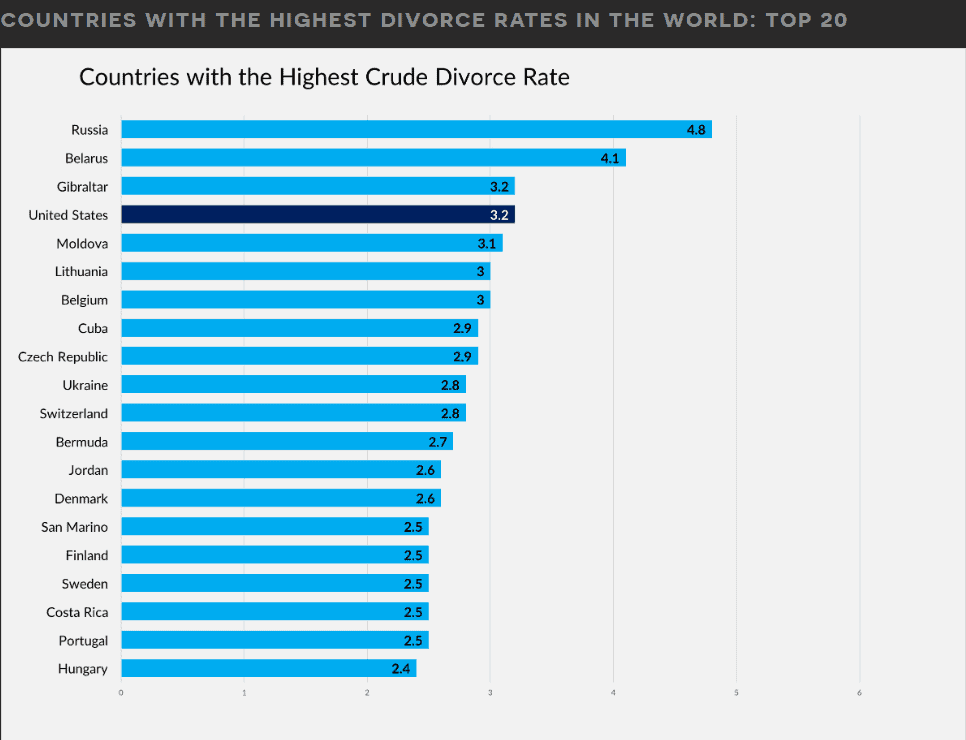
Here we see countries with the highest crude divorce rate. We can see that Russia far outstrips all the other countries listed, with nearby Belarus also being close in divorce rate as well as geographically speaking. The Gibraltar entry is an interesting statistic and one that could well be skewed due to the jurisdiction and legal issues of actual divorce proceedings. It is a very small country, belonging to the UK.
It does, however, share the same divorce rate as the US, who is consequently a joint third in the world when it comes to divorce rates. However, it is a big jump from Russia’s rate of 4.8 to 3.2. Hungary, who is the last entry on the Top 20 comes in at just 2.4 points towards the fact that the divorce rates in other countries are actually pretty low.
In addition, the graph below shows how the marriage rate is in decline all around the world. Argentina is the country with the steepest decline with Australia’s marriage rate declining by a smaller amount than others in the last 20 years.
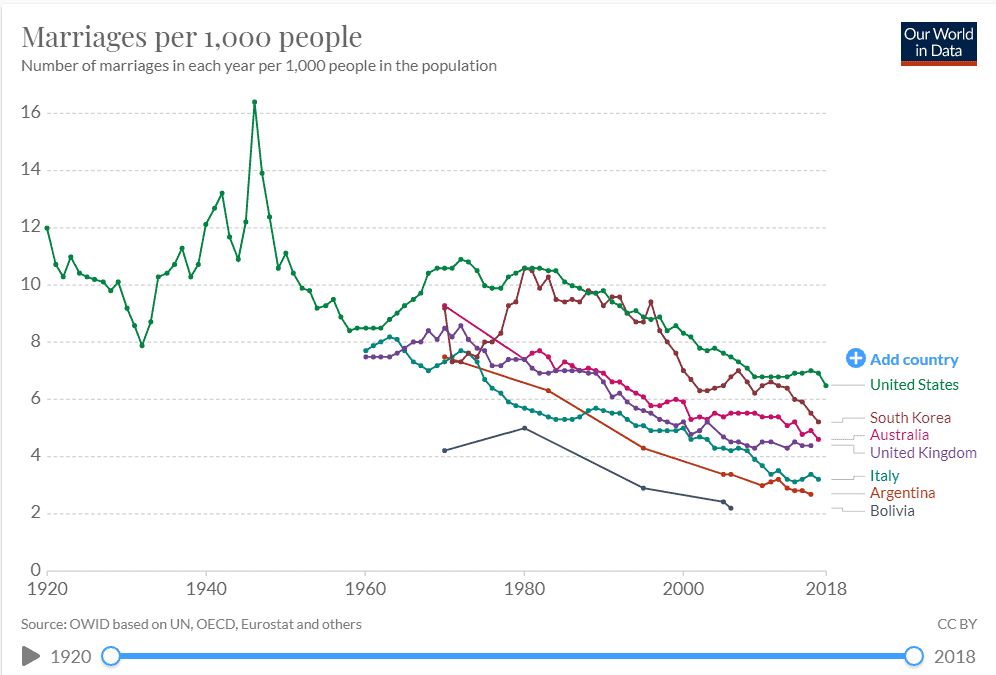

Here we look at the marital status and those that are still in their first marriages. This graph points to why a first marriage may cease to be. It looks at those that end in divorce, but also those take into account the marriages that end due to death.
It is perhaps unsurprising that the amount of people in their first marriage decreases at a quicker rate after the age of 75 when the amount of people widowed sees a sharp increase. Other sharp increases include the first marriage rate after the age of 20 which then tails off when people hit their mid-30s.
The divorce rate lags behind the first marriage rate at all times, but picks up speed after the age of 25 and only starts to decrease when people get to the age of 65 - when death starts to become a bigger reason for the number of people in their first marriage to decrease.
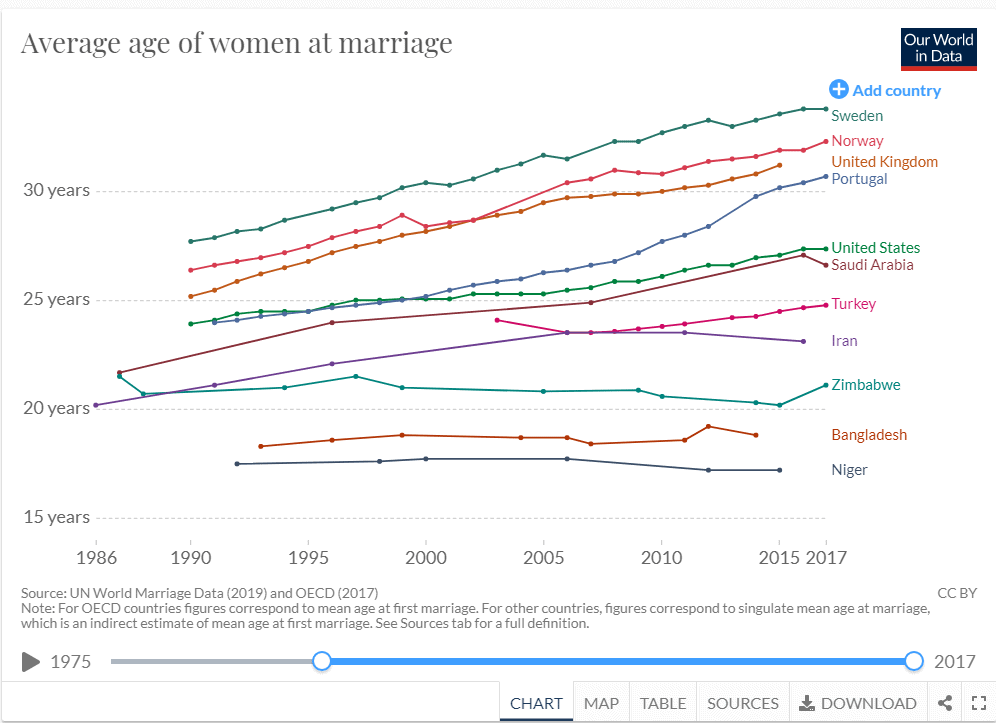
The graph above shows the average age of women when they marry. As can clearly be seen, in the majority of cases in any country, the average age is rising. The only exceptions are Nigeria, Iran, Bangladesh, and for a long while Zimbabwe. In those countries, the average age has only declined by a year or so.
However, in the countries that have seen an upward trend in the average age of women at marriage, that age has gone up at a much quicker and higher amount. Portugal is the most notable example of this that has seen its women have an average age of 31 years old in 2017 in comparison to 26 just 14 years ago in 2003.
In comparison, in Nigeria, the average age of women was around 17 in 2006 and that has decreased to around 16 and a half by 2015. There is no later date for that country, however.
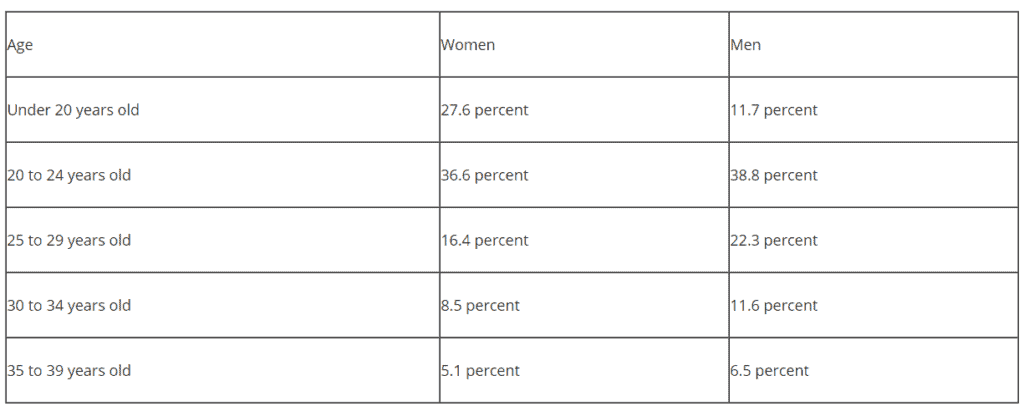
The table above also gives more exact figures behind the age of people and how likely to get divorced they are. It also takes into account gender which puts forward some very interesting marriage and divorce stats.
For example, if a woman under 20 years old gets married, there is a 27.6% chance that her marriage will end in divorce. However, if you are a man of the same age, that falls to just under 12% chance to get divorced.
Use this tool to check whether he actually is who he says he is
Whether you're married or have just started seeing someone, infidelity rates are on the rise and have increased over 40% in the last 20 years, so you have all the right to be worried.
Perhaps you want to know if he's texting other women behind your back? Or whether he has active Tinder or dating profile? Or worse yet, whether he has a criminal record or is cheating on you?
This tool will do just that and pull up any hidden social media and dating profiles, photos, criminal records, and much more to hopefully help put your doubts to rest.
The age that both genders are most likely to get divorced is in the early 20s, which is perhaps unsurprising. In fact, this means that if you are married before you are 24, there is over 50% divorce rate. However, if you marry in your late 30s this drops right down to 5.1% for women, and 6.5% for men.
These pictorial depictions of the divorce rate and marriage rates per state show information on which states have higher than average marriage and divorce data. It shows that there are a number of states that have both a higher marriage rate as well as a divorce rate, while other states have both a lower marriage rate and divorce rate.
Texas, for example, is a state that suffers from a statistically higher amount of marriage and divorce, while California has a statistically lower amount of marriage and divorce throughout the state.
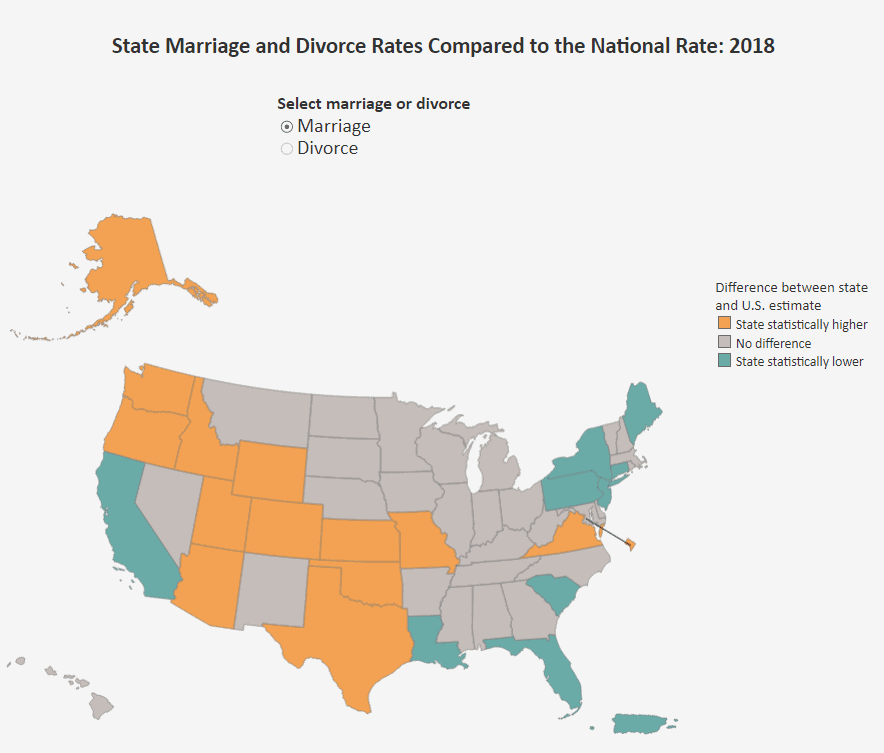
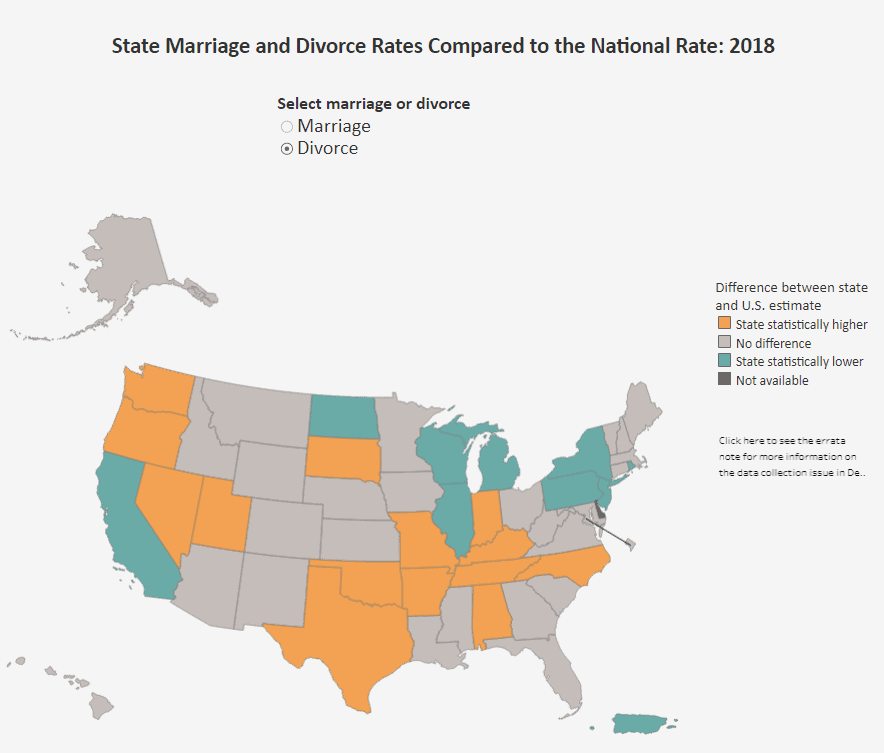
Perhaps unsurprisingly, the jobs that have the lowest divorce rates are the ones that require a person to be at home a lot - or at least in charge of their own spare time so that they can provide consistency to their marriage.
These jobs are also consistent in nature and, while they will always come with their own stresses, they may not be as risky or dangerous as some of the jobs that exhibit a high divorce rate.
For example, an actuary will most likely know his or her deadlines and when their job may become more stressful. However, a gaming manager, bartender, or flight attendant is likely to be away from home an awful lot which will inevitably put a great deal of strain on any marriage - however strong.
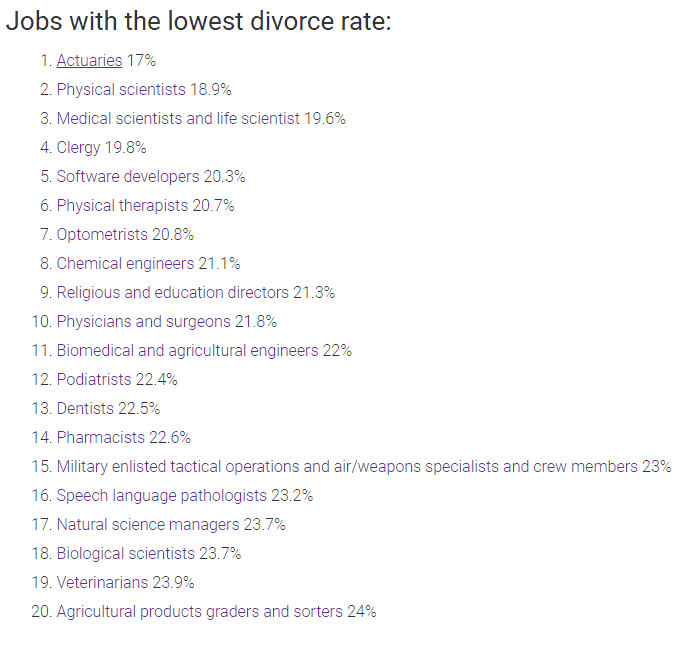
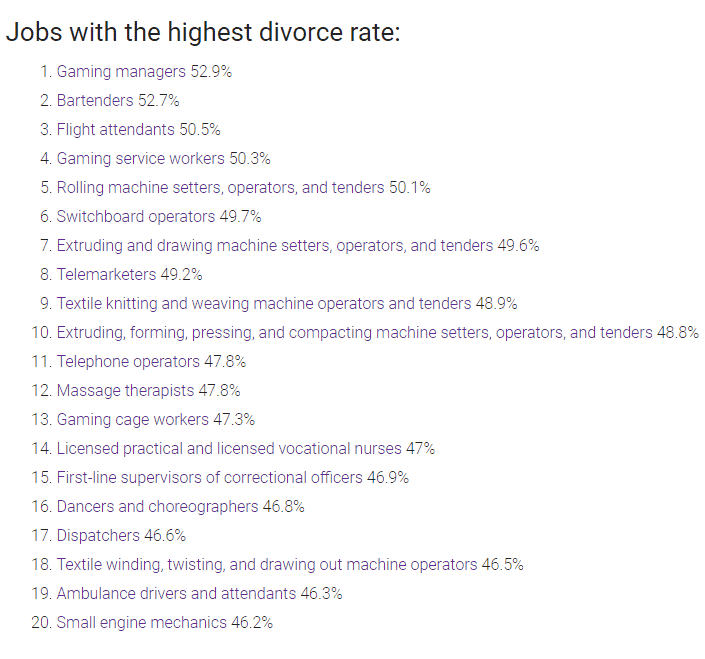
These two graphs go to show the effects that unemployment will have on couples. The data clearly shows that men and women are more likely to see their marriage come to an end and get a divorce if they are unemployed.
Interestingly, it seems to not materially matter what gender you are either for the impact of unemployment to negatively affect a marriage.
In the below graphs, the female line is blue. It shows that there is more of a difference between the number of men and women who are divorced or married more than once if they are employed. For those that are not in the labor force, a man is more likely to be divorced or married more than once.
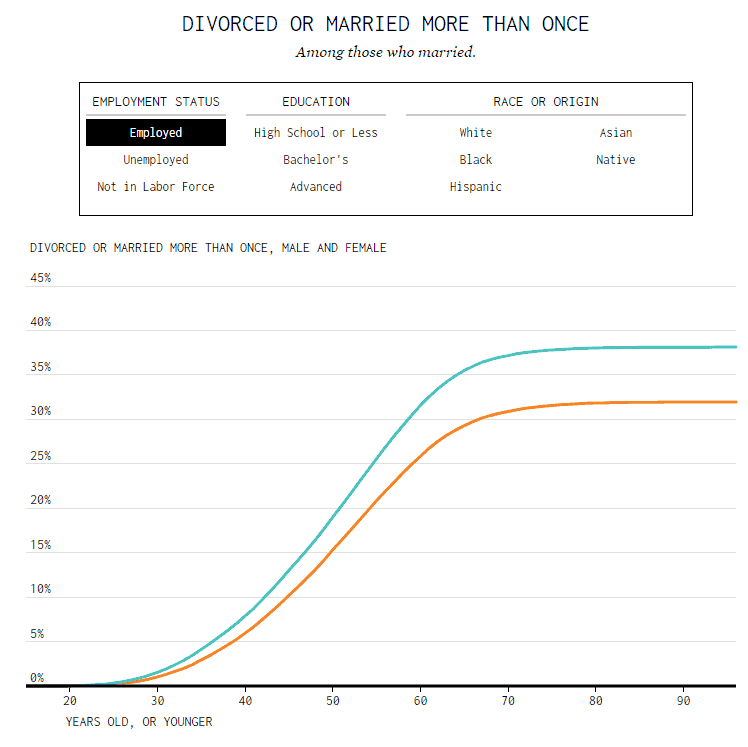
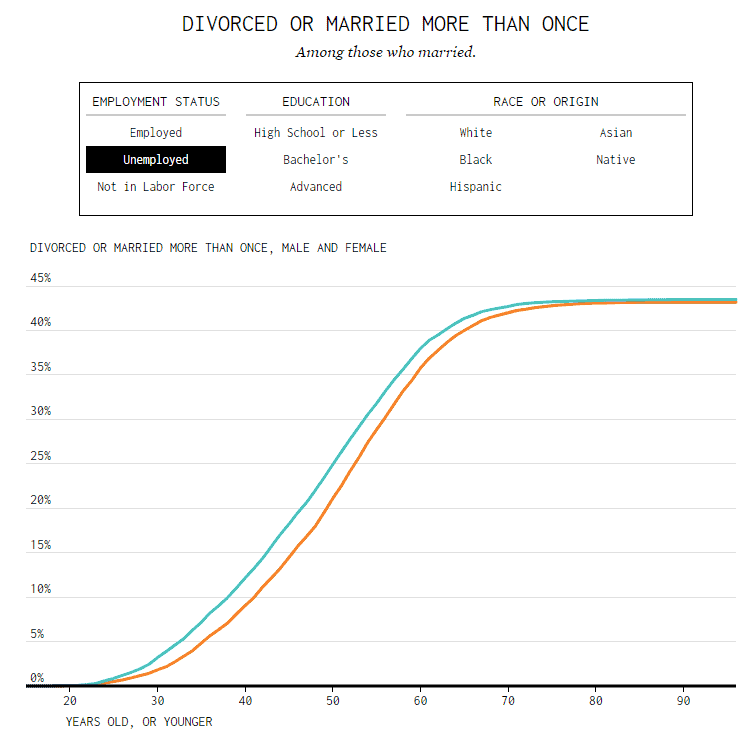
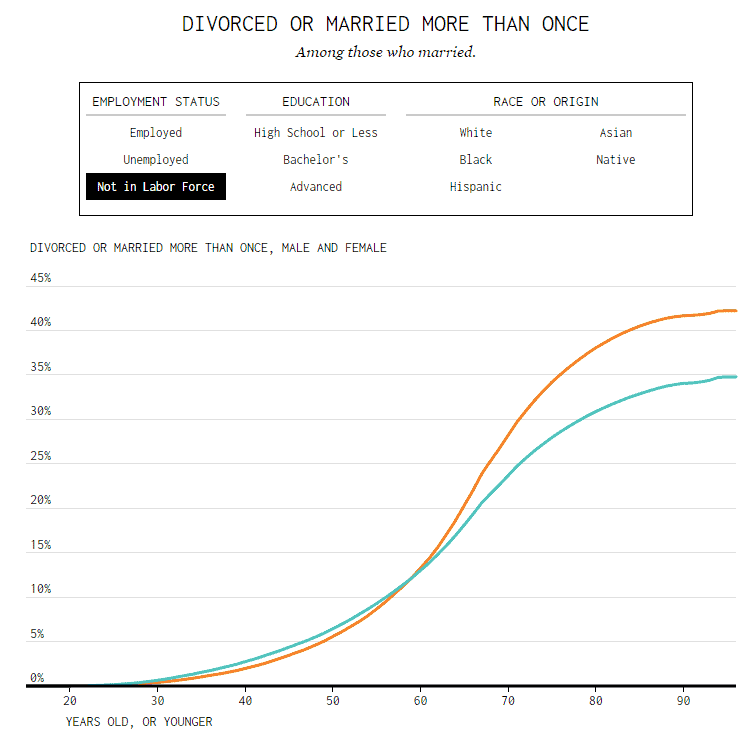
This graph shows that mixed-race couples are still much rarer than any other pairing of marriage in the states. They make up a tiny percentage of the overall figure. The biggest group here is clearly couples made up of purely white, with Hispanic couples being the next biggest set of marriages characterized by ethnicity.
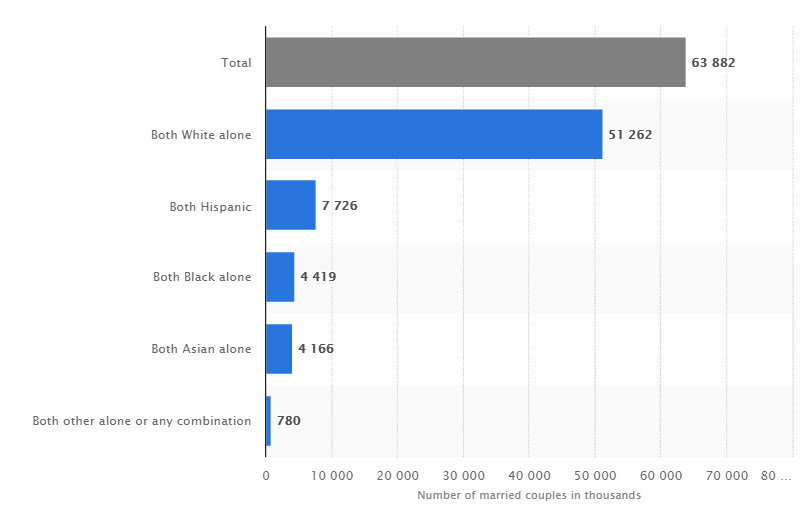
Interestingly, when it comes to religion, there isn’t one that stands out from the crowd in terms of a higher than average divorce rate.
According to data by Pew, historically black protestants are more likely to be divorced with Mormons and Hindus the least likely to have ended their marriage. Across the board of religions and those that don’t believe in anything, marriage is evidently an important marital status with a good proportion of all beliefs being married.
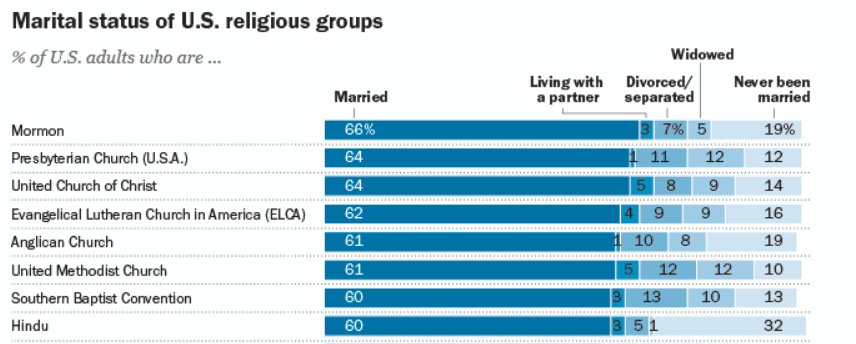
These graphs display information to do with who women marry and who men marry according to education.
Largely speaking, women tend to marry people with similar educational backgrounds - with a couple of anomalies. If a woman has a Ph.D., 33% of them will marry a man with a BA as opposed to 25% with a matching Ph.D. Additionally, if a woman has a Prof. degree, she is likely to be married to a man with a BA 41% of the time as opposed to 30% of the time when he has a corresponding Prof. degree like her. Men display broadly the same educational statistics and data as shown by this graphical information.

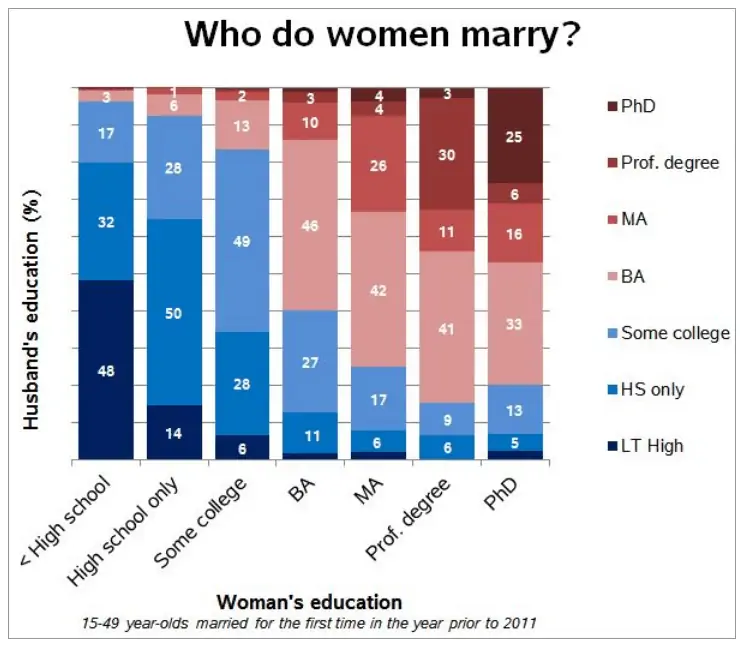
The following graphs show that both men are women are more likely to get a divorce or be in their second or higher marriage if their education is of high school standard or less.
In all categories - high school education, bachelor’s dress, or an advanced qualification, women tend to have a lower divorce rate. However, they do not vary from each other too much in any of those categories. At most, women are 5% less likely to be divorced or onto their next marriage if they have an advanced degree - in comparison to men.
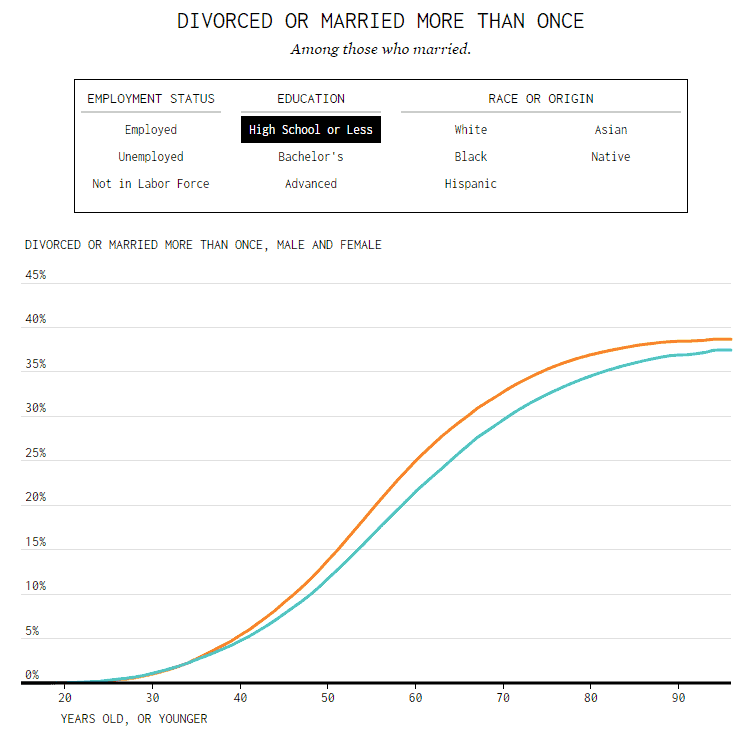
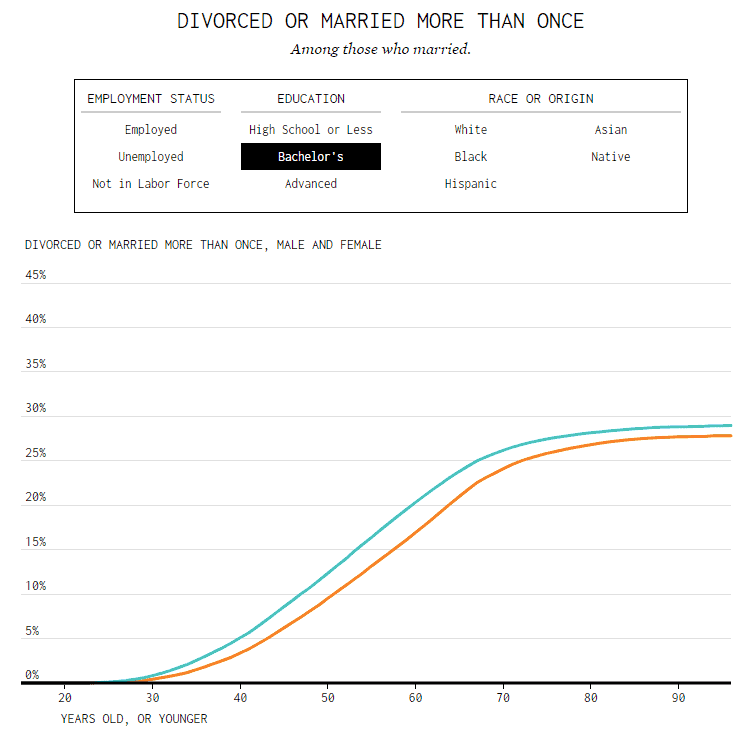

While it remains to be seen whether Republicans or Democrats have a higher or lower divorce rate, or a higher or lower marriage rate, without a doubt, if a couple has differing political views they are more inclined to get a divorce.
Staying happy in a marriage where political and ideological views materially diverge is always going to be an uphill struggle. Couples will find it difficult for political debates not to descend into full-blown arguments that can be hard to come back from.
It is interesting to look at how the marital status of a person can change the amount of divorce is seen.
The number of first marriages that end in divorce is 42%. While that seems quite high, it goes up dramatically if a person remarries for a second time, and even more so if they get married for a third. 60% of second marriages end in divorce, while a huge 73% of people who get married for the third time, get divorced to end the marriage. They are the most likely to get hitched again, but also the most likely to see their marriages end too.
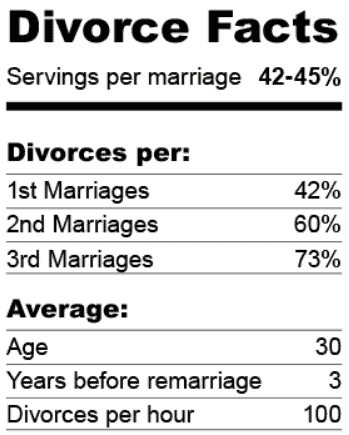
Same-sex marriage is a relatively new idea across many countries. Here, this graph looks at how widely accepted that idea is, and how that level of acceptance has changed in the last thirty years.
It is clear that, while an ever-changing rate of acceptance, there has been a clear change in people’s views across the country. More people now accept same-sex marriage and feel that it should be recognized by law. In fact, only 27% of people thought it should be valid in 1996, compared to 63% now. On the whole, that number has always risen over the last three decades, with it only decreasing in four years.
When considering the view that same-sex couples should not have their marriage recognized by law, this number has come down from 68% in 1996 to 36% now. Again, on the whole, that number has regularly decreased, only rising on five occasions.
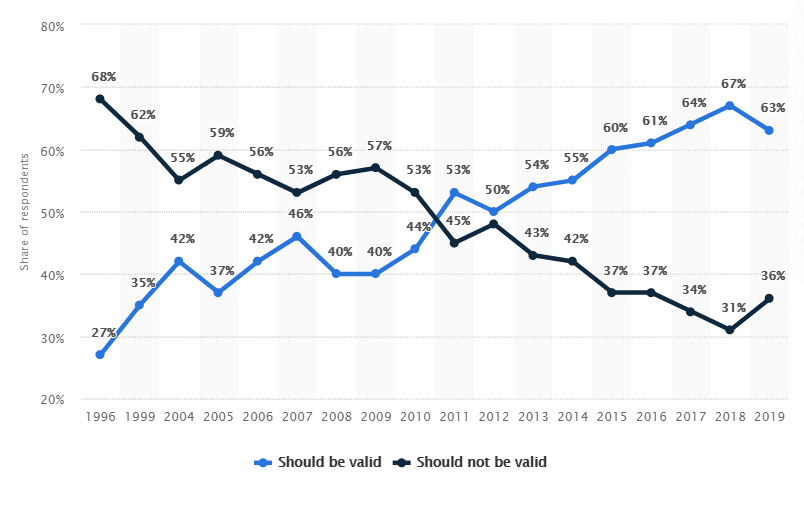
Looking at people’s approaches and attitudes to marriage and divorce can be an interesting debate topic. People’s attitudes to marriage and divorce have changed greatly over the years - presumably as religion starts to take less of a dogmatic influence in our lives.
Here, in this graph, we see that the majority of the population think that marriages that end in divorce are morally acceptable situations. Those who are against divorce entirely make up a fifth of the population, while 3% believe it depends on the situation, and 1% having no opinion on the matter entirely.
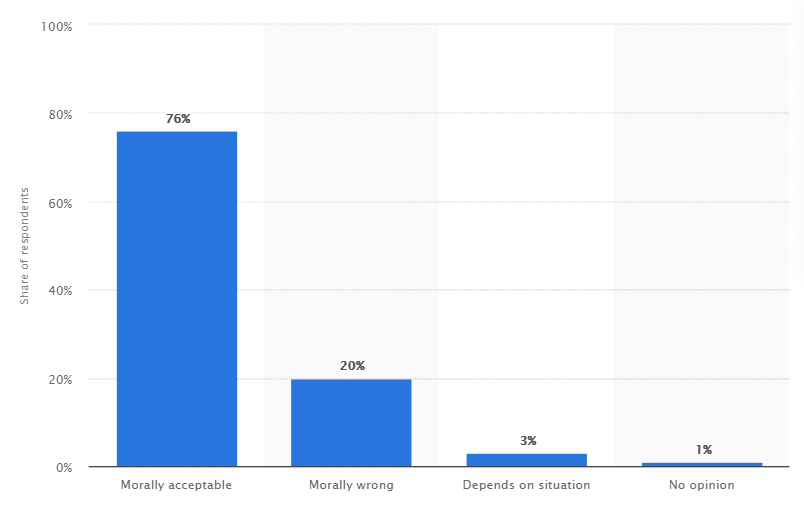
Here, we look at marriage and divorce by state in terms of how long each state’s average marriage lasts for. It is clear to see that South Dakota and West Virginia have the best success rate when it comes to the length of a marriage before ending in divorce.
The North East in general seems to have more success when it comes to an overall region having longer marriages of about 20 years and higher. Main, New Hampshire, and Vermont, as well as Wisconsin and Pennsylvania, all have long marriages.
The states that have the lowest median marriage numbers are Nevada and Utah who have marriages that last around 16 years on average. Colorado and Texas also have marriages that last around 17 years long.
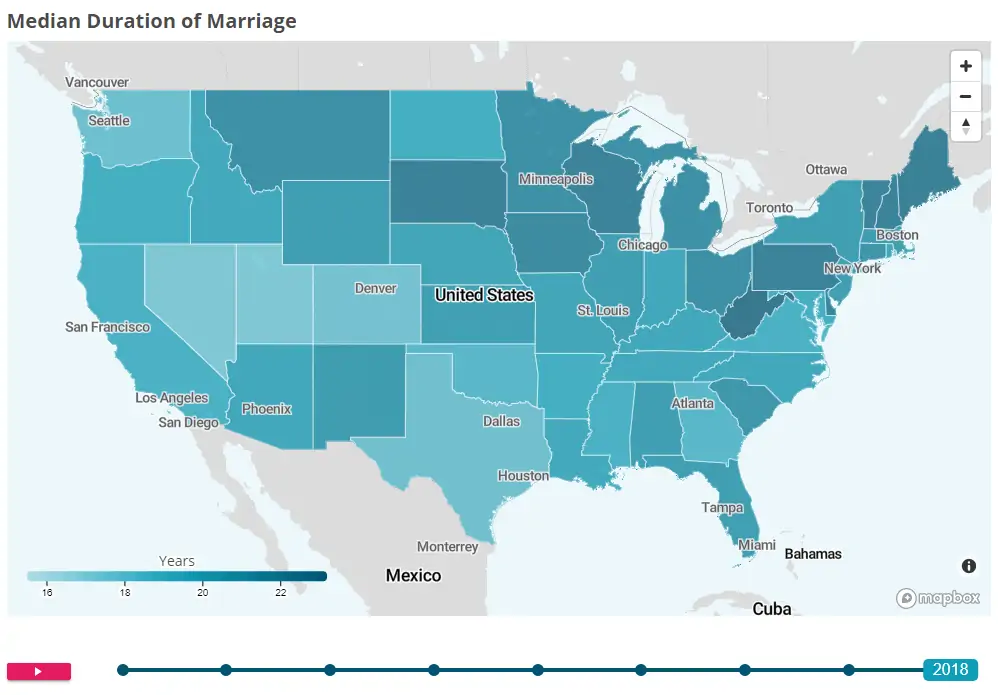
Here we look more exactly at how long people are married for before their marriage starts to become a divorce statistic. For a first marriage, males will usually be married for almost 8 years, with women being about the same.
However, for the second marriage, the length of time that two people stay together before they get divorced is less - males will get divorced after 7.3 years, with women seeking a divorce after 6.8 years.
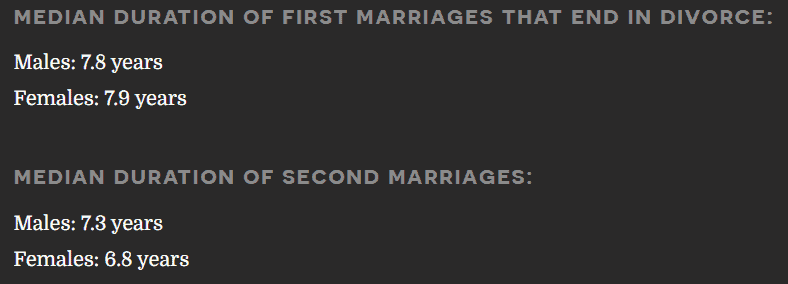
There are a number of reasons why some marriages end and why others seek a divorce. Here, we look at what increases your risk of a divorce and what makes couples less likely to add to the divorce rate.
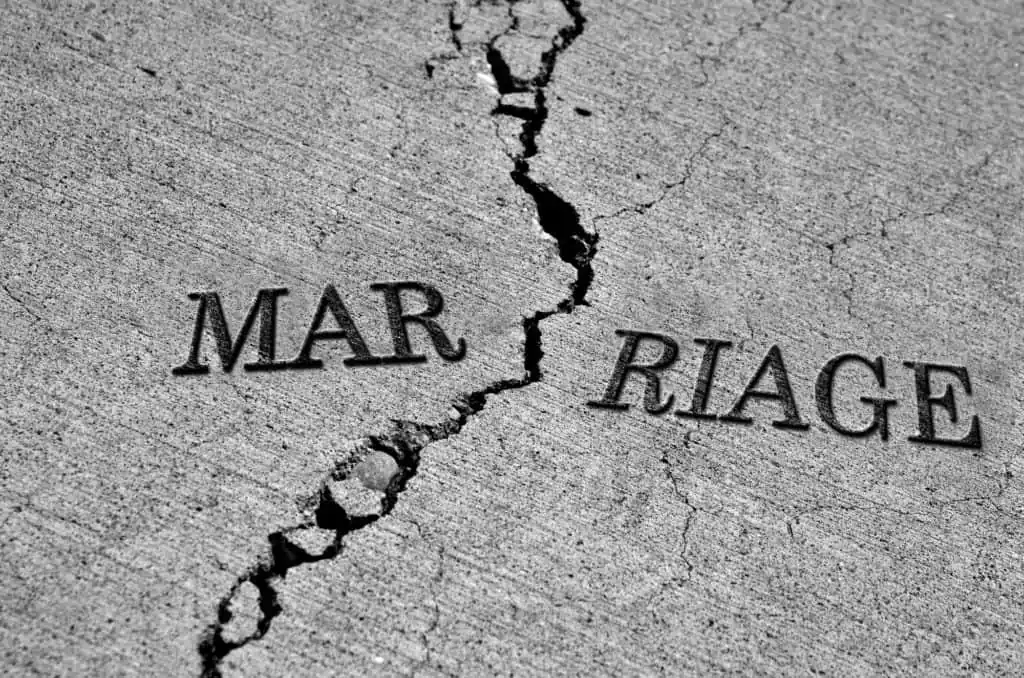
The information gathered by McKinley Irvin recently underlines the fact that age has a massive part to play in increasing or decreasing the amount of couples who divorce. The younger that two people move in together or decide to marry, the more likely they are to break up and divorce.
Another information that was found to increase the chances of divorce is if you work within a company that has more people of the opposite sex. This could mean a couple of things - there is more daily temptation for a person who can see that there may be life in another relationship. This does not mean they necessarily commit adultery, but it may just give them hope that they can be happy with another person. Also, if you have many friends or family members who have recently gone through a divorce, you are more likely to take the same decision.
Religion can also play a part - if you live somewhere that has a very high population of Protestants, you increase your risk of divorce. Other curious data include the fact that the bigger the ring or the wedding, the shorter the or less successful the marriage. Finally, if you marry someone considerably younger or older than you, you are vastly increasing your chances of your marriage ending in divorce.
However, there are many ways that you can become less likely to get a divorce. For starters, if you decide to marry or live with your partner after the age of 23, this seems to make your changes of having a happy marital status much better.
Divorce rates also decrease if you have been to college as well as if you choose to have a baby after you marry. Money also plays a big part in that if you have an income of over $25,000 you materially improve your chances of not adding to divorce rates. Finally, if your parents are still together then your marriage is much less likely to end in divorce.
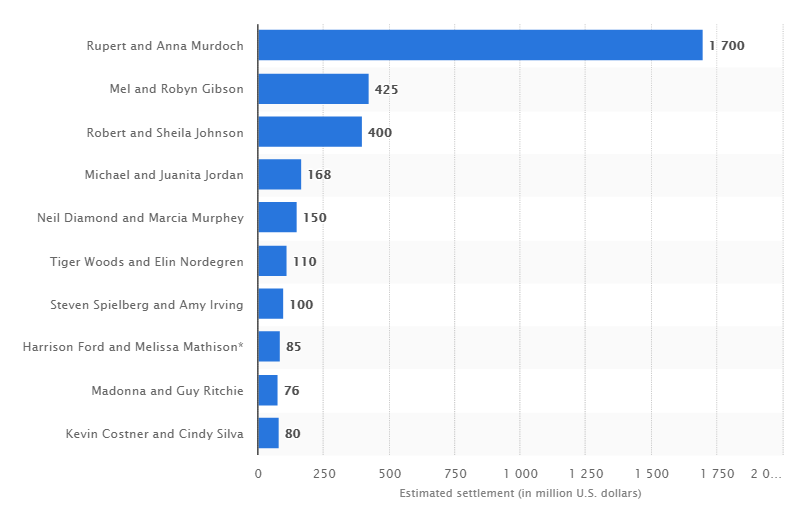
Celebrity divorces seem far more common than everyday divorces. Whether there is data to actually back up that information is unclear. Perhaps the reason that they seem more common is simply that they are in the media a lot more and broadcast for us all to read about - whereas an average person’s divorce is most likely to get no coverage at all. In fact, many of those who see their marriage result in divorce probably do their best to keep it as private as possible.
Celebrity divorces are interesting, however, in terms of how much money the divorce settlement ends up being. Marriage and divorce sadly come down to a financial sum for many marriages and those fighting the legal battle.
One of the most expensive divorces in history came at the marriage end of Ruper and Anna Murdoch. This saw Anna Murcdoch walk away with $1.7billion. Jeff Bezos has also recently divorced his wife for an eye-watering amount which was one of the most talked-about divorces ever seen.
Another much-spoken about marriage and divorce was between Tiger Woods and his then-wife Elin Nordegren. His countless indiscretions finally came back to haunt him and the once golden boy of the sporting world saw both his fame and fortune in tatters. He was the first billionaire sportsman, but when his wife walked away with over $100million, it was more than his reputation that had been badly hit.

In the last 20 years, since the mass usage by the population of social media platforms like Facebook and Twitter, relationships have been affected in many different ways. Firstly, people can use social media platforms to get together in the first place. This can mean using dating apps or simply approaching a person over their social media page. Platforms also give people the opportunity to chat with each other which can help form connections that otherwise may not have come about.
However, social media usage, itself, can have a negative effect on couples. There is a lot of data and information available that goes to show that marriage and divorce can be a victim of both how much a person uses social media but also what they use it for.
Information gathered by McKinley Irvin shows that one in three divorces start due to one of the individuals starting a relationship online. In terms of arguments over usage, 25% of all couples will argue about how much one of them is using Facebook each week.
This usage then translates into annoyance and hurt over that social media activity with one in seven in a marriage thinking about divorce because of that very behavior. It is also very common for couples to hit the rocks after a person discovers something about their partner through their own Facebook account.
While this won’t always mean that they discover infidelity (check our article on infidelity statistics to find more information on that), many couples (14%) use their partner’s social media accounts for data and information on their cheating for divorce proceedings.
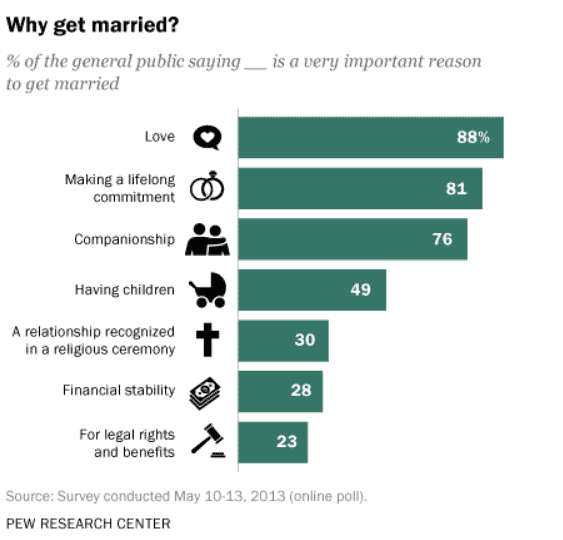
So why do people agree to marriage in the first place if the divorce rate is so high - even for the first marriage? Perhaps reassuringly, 88% admit to getting married for love and with a big 81% of those in marriage saying they wanted to make a lifelong commitment.
At the other end of the scale, 23% of married couples marry, according to information collated by Pew Research, for legal rights or benefits.
Additionally, the data shows that 28% of people marry for financial stability. While it’s reassuring to know that so many people marry because they are couples in love, with 23% of people marrying for benefits with a huge 28% marrying for financial stability, the information points out that a quarter to a third of all marriages takes place for reasons other than love, commitment, and companionship.
Finally, this information highlights how having children is also a driving force behind improving your marital status. Whether people are getting married because they have children so they want to marry for the sake of them or whether they are getting married because they want to have children in the future is unclear from this information. However, it is clear that children are a major factor behind couples walking down the aisle.
There are many common reasons for any number of marriages ending in divorce. Divorce rates increase when either one of the couples believes that the other has a distinct lack of commitment. This has obvious implications on the happiness of both people within marriage and divorce often follows as a consequence.
Another obvious reason for divorce that won’t surprise many people is if there has been infidelity or any extramarital affairs. However, there was also a large number of people claiming that they got married too young and that also they simply argued too much so divorce seemed like their only option. Financial problems were also the other biggest cause of a divorce, with a couple agreeing 50% of the time that this was a major issue in the breakdown of their marriage.
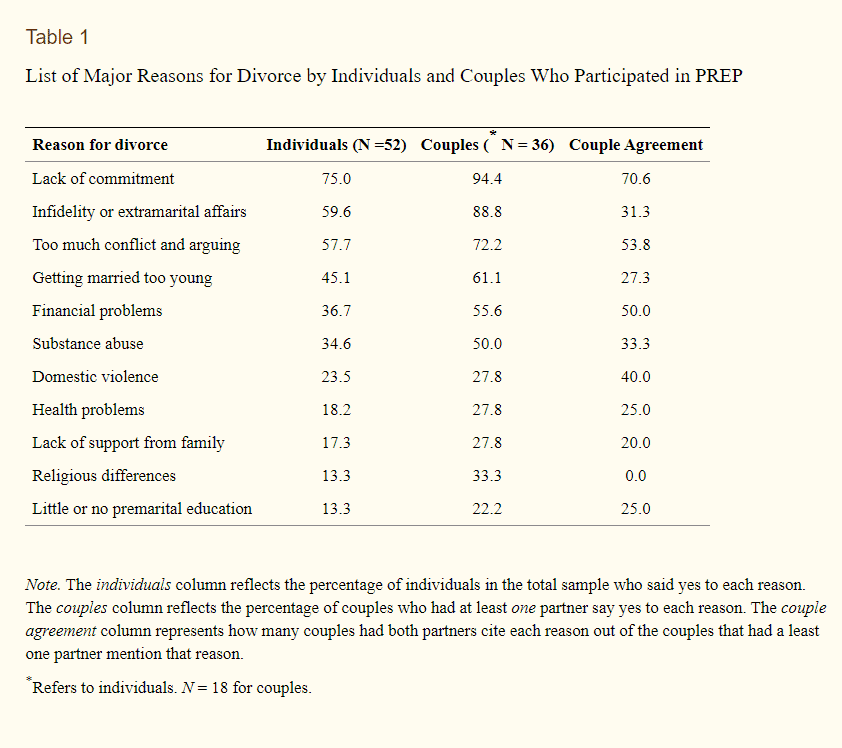
Another data collated by WF lawyers is also information that points to why marriage and divorce may occur between two people. Lack of commitment is, again, the most common issue that will bring about the end of a marriage, and arguing too much is the second most common problem. Infidelity again is another big driver of the divorce rate with over half of all divorces occurring due to a person’s cheating or alleged infidelity.
Marriage and divorce in a parents’ relationship can materially affect a person’s own marriage and divorce rate. If a person comes from a broken marriage, whether it is the first marriage or not, they are more likely to see their marital status end in divorce too.
It is often because they will not have had the right experience of a marriage that works constructively to remain happy overall. Marriage and divorce are both largely dependent on how well a couple can communicate with one another. If they can’t communicate well, they will more likely be a marriage that ends in divorce. If someone hasn’t seen firsthand how to communicate properly, but instead only sees how to communicate poorly - that is what they will learn from.
Additionally, coming from a broken marriage also makes a person far more likely to suffer from commitment issues as well as have a fear of intimacy that can also lead to a fear of abandonment that materially reduces their ability to be in a long-lasting, happy relationship.
Children are often a sum total of the inputs that they saw in their formative years. If those children did not have a good example of a healthy relationship - however good the intentions of their parents were - they are far more likely to be unable to be in a happy marriage in the future.
One thing that seems common across all divorce is that parents either have tried to save their marriage for the sake of the kids or at least if a divorce is going ahead, they want to ensure that the ending of the marriage and divorce proceedings don’t negatively affect their children.
Here we look at some of the effects that marriage and divorce can have on children. The first being what the information is on children who have had to repeat a grade.
Data collated by the National Center for Health Statistics have shown that while a child whose family structure includes two biological or two adoptive parents are 6.5% likely to have to repeat a grade, that goes up to around 20% or more if they have any other home life. This structure could mean either living or having stepparents or simply living only with a mother.
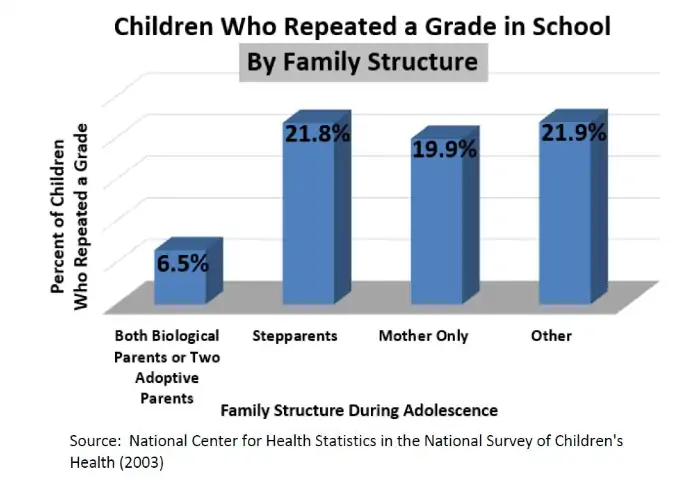
This graph shows the effects on a child’s ability to achieve the highest grades at school. Bearing this in mind, a child who is living with both their parents will achieve mostly As around 30% of the time. This falls to 9% if children is always living with a single parent.
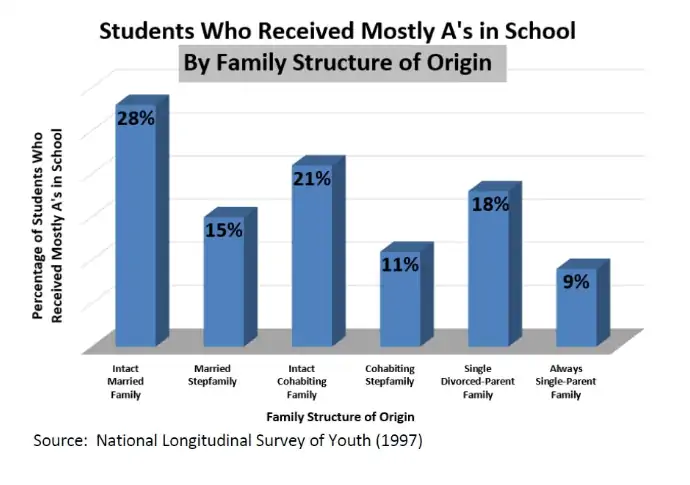
Another one of the reasons that people may delay marriage and divorce is down to finances. Some will put off marrying as they save up for an expensive wedding, while some couples delay divorce owing to the sky-high legal fees. Here, we break down those financial marriage and divorce costs a little more closely.
When it comes to marriage, the average expenditure for a wedding is high, wherever you live. Couples that are marrying in the state of Rhode Island can expect to pay over $52,000 for their wedding. However, for those that live in Utah, that figure goes right down to $18,516. While this is still a lot of money, the information shows that this is over 50% less of a Rhode Island wedding.
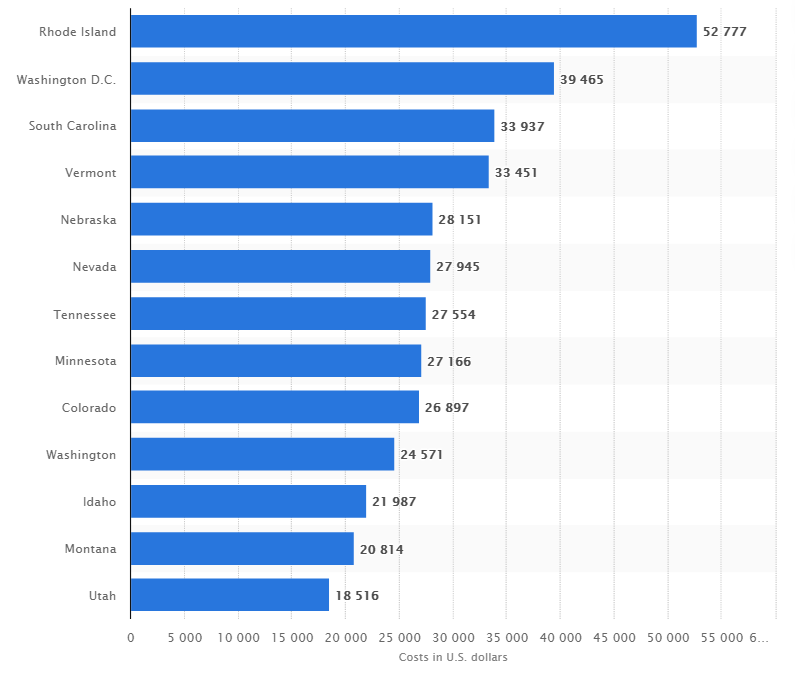
For divorce, the costs can really rack up very quickly, depending on what legal proceedings you have to carry out to finalize the end of your marital status.
Court fees for a short, two-day trial will cost couples $25,000. The cheapest divorce, however, is one that sees collaborative law negotiations which will cost each individual $3,000. However, the information extrapolates what the average minimum amount is for each divorce is $15,000.
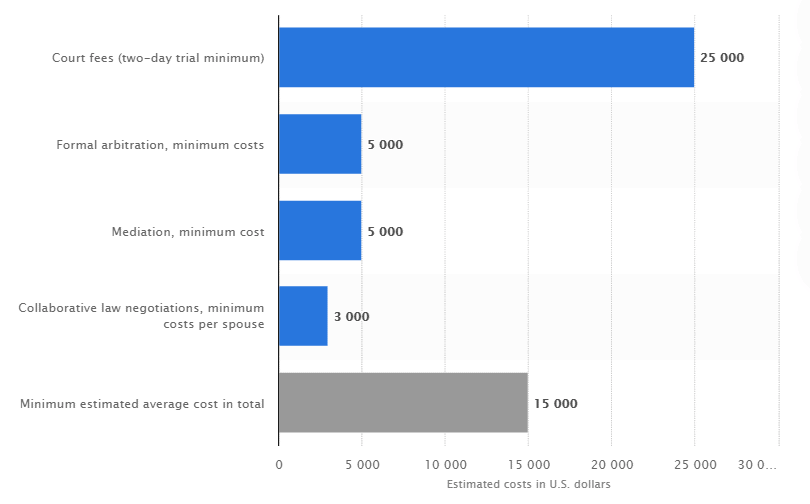
One of the biggest issues that couples have to contend with when they split and divorce is what happens to the children that they have.
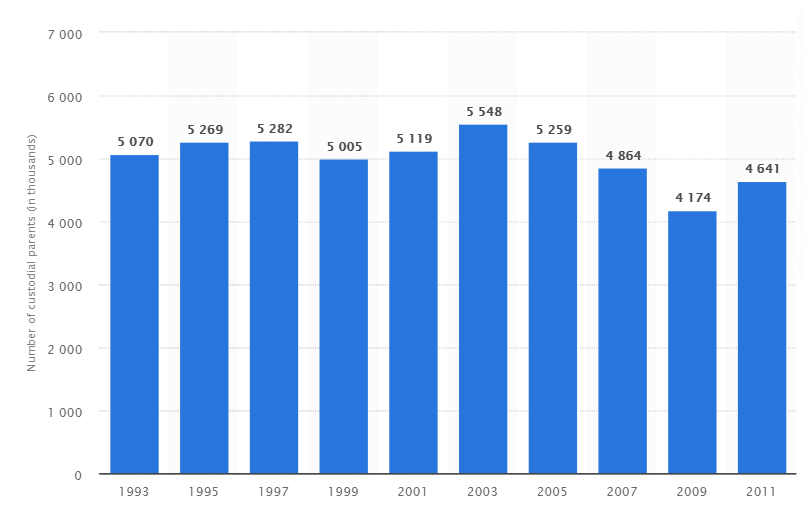
Here, we look at the data behind child support and divorce and how the numbers have varied over the time between 1993 and 2011. While there was a large dip in 2009 for the amount of custodial parents, the number tends to stick around the same 5 million mark. However, it went to just over 4 million in 2009 and has yet to go back up to its peaks of 5.5 million in 2003.
Child custody is obviously a big problem that couples face when they start to seek the help of a divorce lawyer. So it’s interesting to see that while the divorce rate is dropping, the number of marriages that end up with a custody battle on their hands by and large stays the same, with only a dip being seen in very recent years.
This could be to do with the balancing out of gender roles so that children are less likely to only be given full custody under their mothers.
Of course, all these statistics do not take into account the men and women who don’t fall into this information collation. Those will be people whose marital status is separation or even something even more modern.
Not everyone who breaks up with their marriage partner will automatically get divorced. This can skew the information on the men and women who are in their first marriage or later, but actually are no longer with their partner.
Getting remarried is becoming a far more common thing to do after a first marriage has broken down. Marriage and divorce have changed in people’s opinion culturally speaking so that getting married to someone who has previously been married is no longer stigmatized or frowned upon. For that reason, divorce (as we have seen) is common even if the rate is falling.
However, remarriage is on the rise - particularly with those that are the baby boomers’ age.
According to information found by the Pew Research Center, while 42% of divorcees above 50 remarried in 1980, that number has risen to 57% by 2013. Other age groups saw a decline in that time. Those between the age of 18-34 saw a decrease from 72% in 1980 to 42% in 2013, with 35-54 years olds’ age bracket going from 72% to 60% in the same time frame.
Interestingly, the same study showed information data that displayed that men have always been more likely to remarry than women - whatever their age.
The amount of marriages that end in divorce change slightly depending on what marriage people are in. For couples that are in their first marriage, there is currently a 42% divorce rate. For those in the second marriage that goes up into the 60th percentile, with third marriages ending 73% of the time.
For both men and women, a divorce process will often start around the end of the 8th year of their marriage. However, divorce petitions are started slightly earlier in 2nd marriages, which end around the 7th year of marriage.
The divorce rate in America in 2019 is around 3 in every 1,000 marriages. This will take into account all marriages. This is not the rate for first marriages alone.
The statistics that support what percentage of 5th marriages that end in divorce are not sound enough to be reliable. The reason being is that 5th marriages are quite rare and so there is not a way to collate the data fairly and robustly for them to be able to be used in a meaningful way.
The number one reason for divorce comes down to lack of commitment issues. It may surprise people that infidelity is not the biggest reason. The stresses and implications of financial difficulties or anxieties can also play a huge part in why couples break up.
Seeing marriage and divorce data investigated in the round like this is an interesting way to look at how both have changed over the years.
However, marriage and divorce are also clearly affected by a person’s age, a person’s age when they married, and what a person does for a living - in addition to a whole host of other factors. These can include where they live, what their education was, and if their parents’ are divorced or still together.
Utilize this tool to verify if he's truly who he claims to be
Whether you're married or just started dating someone, infidelity rates have risen by over 40% in the past 20 years, so your concerns are justified.
Do you want to find out if he's texting other women behind your back? Or if he has an active Tinder or dating profile? Or even worse, if he has a criminal record or is cheating on you?
This tool can help by uncovering hidden social media and dating profiles, photos, criminal records, and much more, potentially putting your doubts to rest.
